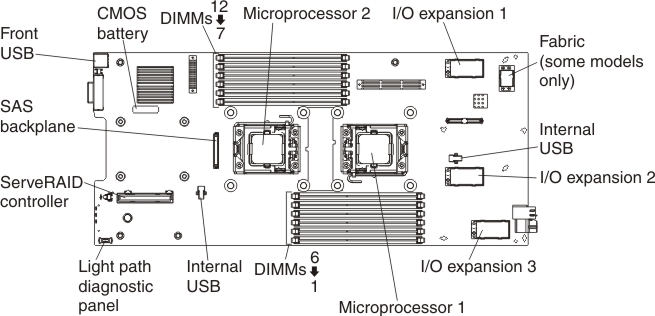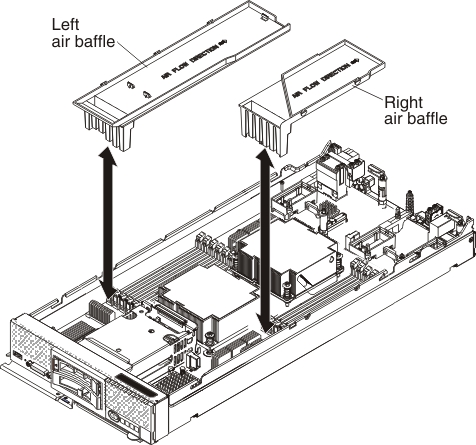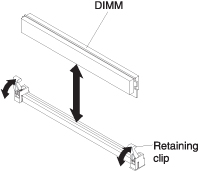Installing a DIMM
Use this information to install a DIMM.
- Read Safety and Installation guidelines.
- Read the documentation that comes with the DIMMs.
- If the compute node is installed in a Flex System chassis, remove it (see Removing a compute node from a chassis for instructions).
- Carefully lay the compute node on a flat, static-protective surface, orienting the compute node with the bezel pointing toward you.
This component can be installed as an optional device or as a CRU. The installation procedure is the same for the optional device and the CRU.
After you install or remove a DIMM, you must change and save the new configuration information by using the Setup utility. When you turn on the compute node, a message indicates that the memory configuration has changed. Start the Setup utility and select Save Settings (see Using the Setup utility for more information) to save changes.
- Verify that the amount of installed memory is the expected amount through the operating system, by watching the monitor as the compute node starts, by using the CMM sol command, or through Flex System Manager management software.
- For more information about the CMM sol command, see the "Flex System Chassis Management Module: Command-Line Interface Reference Guide".
- For more information about Flex System Manager management software, see the "Flex System Manager Software: Installation and Service Guide".
- Run the Setup utility to reenable the DIMMs (see Using the Setup utility for more information).
The compute node supports low-profile (LP) DDR3 DIMMs with error-correcting code (ECC) in 2 GB, 4 GB, 8 GB, and 16 GB capacities.
The following illustration shows the system-board components, including the DIMM connectors.

The compute node has six memory channels with two dual inline memory module (DIMM) connectors each, for a total of 12 DIMM connectors. Three channels are associated with each of the two microprocessors. The following table lists the channels that are associated with each microprocessor and the DIMM connectors in each channel.
| Microprocessor | Memory channel | DIMM connectors |
|---|---|---|
| Microprocessor 1 | A | 1 and 2 |
| B | 3 and 4 | |
| C | 5 and 6 | |
| Microprocessor 2 | D | 11 and 12 |
| E | 9 and 10 | |
| F | 7 and 8 |
Depending on the memory mode that is set in the Setup utility, the compute node can support a minimum of 2 GB and a maximum of 192 GB of system memory.
- You cannot mix UDIMMs and RDIMMs in the same compute node.
- You cannot mix non-mirrored-channel and mirrored-channel modes.
- A total of eight ranks on each channel is supported.
- If a quad-rank DIMM is installed, install it in the connector at the end of the memory channel.
- If a channel has one or more quad-rank DIMMs, only two DIMMs per channel is supported.
- Populate the DIMMs on microprocessor 1 first and populate the DIMM on the closest channel to the microprocessor first.
- Populate the farthest DIMM slot on the channel first.
- Different memory modes require a different population order.
- DIMM slots 2, 4, 6, 7, 9 and 11 must be populated (actual DIMM or DIMM filler).
- DIMM slots 1,3, 5, 8, 10 and 12 do not require a DIMM filler.
- Independent-channel mode: Independent-channel mode provides a maximum of 96 GB of usable memory with one installed microprocessor, and 192 GB of usable memory with two installed microprocessors (using 16 GB DIMMs). See Independent-channel mode for additional information.
- Rank-sparing mode: In rank-sparing mode, one memory DIMM rank serves as a spare of the other ranks on the same channel. The spare rank is held in reserve and is not used as active memory. The spare rank must have identical or larger memory capacity than all the other active DIMM ranks on the same channel. After an error threshold is surpassed, the contents of that rank are copied to the spare rank. The failed rank of DIMMs is taken offline, and the spare rank is put online and used as active memory in place of the failed rank. See Rank-sparing mode for additional information.The following notes describe additional information that you must consider when you select rank-sparing memory mode:
- Memory sparing on one channel is independent of the sparing on all other channels.
- You can use the Setup utility to determine the status of the DIMM ranks.
- If only one DIMM is present in a channel and the DIMM is dual or single rank, then sparing mode should not be enabled.
- Mirrored-channel mode: In mirrored-channel mode, memory is installed in pairs. Each DIMM in a pair must be identical in capacity, type, and rank count. The channels are grouped in pairs with each channel receiving the same data. One channel is used as a backup of the other, which provides redundancy. For each microprocessor, the memory contents on channel 2 are duplicated in channel 3, channel 1 is unused. The effective memory that is available to the system is only half of what is installed. See Mirrored-channel mode for additional information.
One DIMM for each microprocessor is the minimum requirement. However, for optimal performance, install DIMMs in sets of four so that you distribute memory equally across all channels. If two microprocessors are installed, distribute memory across all channels and equally between the microprocessors. Install DIMMs in the order as indicated in the following table for independent-channel mode and rank-sparing mode.
To install a DIMM, complete the following steps:
- Install the cover onto the compute node (see Installing the compute node cover for instructions).
- Install the compute node into the chassis (see Installing a compute node in a chassis for instructions).

